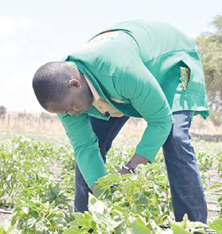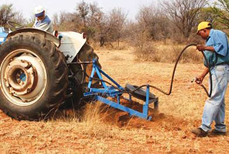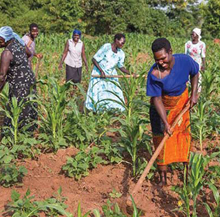How Syngenta has Made Me Succeed as a Farmer
Noah Kadima, a respected ‘agri-preneur’ shares the story of his progress under The Good Growth Plan.
 About 13 years ago, Noah Kadima was trying to get started as a farmer, keen to try out the various promising farm inputs available on the market. Today, with trial and error and experience under his belt, Mr Kadima has become a respected farmer and ‘agri-preneur’ among his network, thanks to Facebook, and beyond.
About 13 years ago, Noah Kadima was trying to get started as a farmer, keen to try out the various promising farm inputs available on the market. Today, with trial and error and experience under his belt, Mr Kadima has become a respected farmer and ‘agri-preneur’ among his network, thanks to Facebook, and beyond.
In fact, Kadima has recently launched the Africa Farmers Club to offer fellow farmers guidance and advice on how to manage their crops and their farms. Through the club and his collaboration with agricultural company Syngenta, Mr Kadima is giving farming a new definition as a profitable business.
Kadima is part of Syngenta’s sustainable initiative called The Good Growth Plan (GGP), which provides guidance to farmers on good agriculture practices. The aim is to promote more efficient and more sustainable farming to increase land productivity and resilience. “Three years into farming and the challenges were so real. I started off so excited. I really wanted to get into this farming business. But at the same time getting information on how to go about it was a challenge,” Mr Kadima recalls.
Read more ...
Mechanisation: Minimising Your Costs
 Properly maintained, a good secondhand tractor will give its new owner years of service. Have big-ticket used machinery checked by someone competent to spot problems and ask the right questions. Once the tractor is yours make daily checks part of the routine operating procedure for the operator.
Properly maintained, a good secondhand tractor will give its new owner years of service. Have big-ticket used machinery checked by someone competent to spot problems and ask the right questions. Once the tractor is yours make daily checks part of the routine operating procedure for the operator.
It is both difficult and unwise to cut corners if you have to plant high-quality seed and make sure they receive proper irrigation. But mechanisation costs are often unnecessarily high and looking at these again could result in lower input costs and higher profits.
Read more ...
 Selection of the right seed variety is most determining factor for a farmer to make good returns in his investment. You should make the right decision from the beginning because once you put that seed in the ground there will be no turning back until its maturity.
Selection of the right seed variety is most determining factor for a farmer to make good returns in his investment. You should make the right decision from the beginning because once you put that seed in the ground there will be no turning back until its maturity. Input (production) costs are a fact of life for every farmer, so the best course of action is to see what can be done to minimise their impact on your farming operations and ultimately on the bottom line (profits).
Input (production) costs are a fact of life for every farmer, so the best course of action is to see what can be done to minimise their impact on your farming operations and ultimately on the bottom line (profits). About 13 years ago, Noah Kadima was trying to get started as a farmer, keen to try out the various promising farm inputs available on the market. Today, with trial and error and experience under his belt, Mr Kadima has become a respected farmer and ‘agri-preneur’ among his network, thanks to Facebook, and beyond.
About 13 years ago, Noah Kadima was trying to get started as a farmer, keen to try out the various promising farm inputs available on the market. Today, with trial and error and experience under his belt, Mr Kadima has become a respected farmer and ‘agri-preneur’ among his network, thanks to Facebook, and beyond. Properly maintained, a good secondhand tractor will give its new owner years of service. Have big-ticket used machinery checked by someone competent to spot problems and ask the right questions. Once the tractor is yours make daily checks part of the routine operating procedure for the operator.
Properly maintained, a good secondhand tractor will give its new owner years of service. Have big-ticket used machinery checked by someone competent to spot problems and ask the right questions. Once the tractor is yours make daily checks part of the routine operating procedure for the operator.